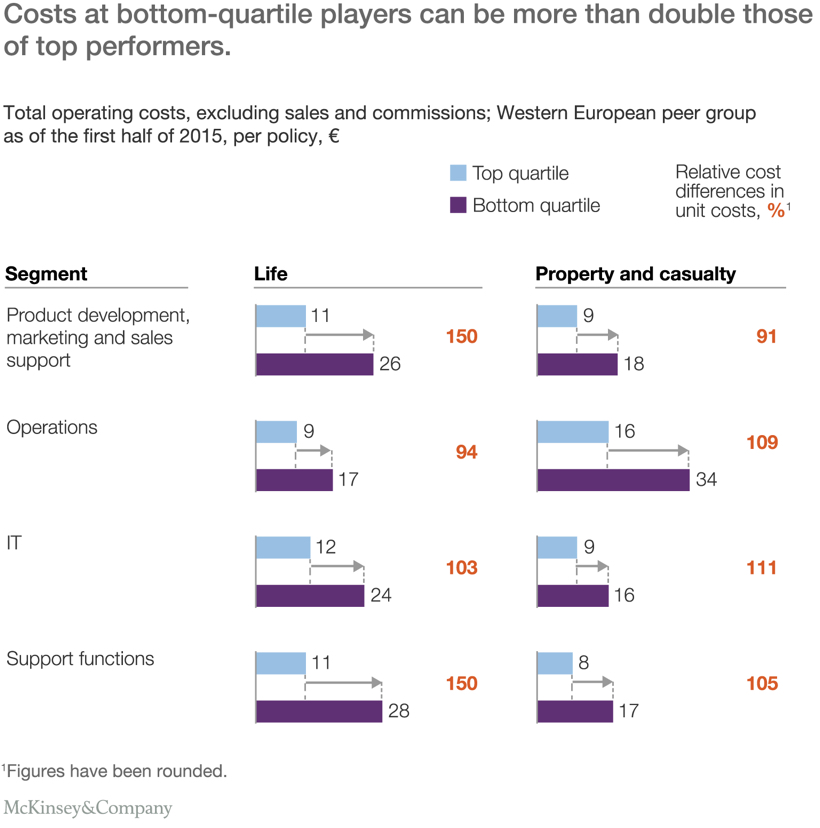
Image by: Photodisc, ©2016 Getty Images

Source: "Successfully reducing insurance operating costs: Insights from McKinsey’s Insurance 360° benchmarking," 2015.
The ability to cut costs is always top-of-mind for management; however, they tend to look at the bottom line rather than the full scope of factors diminishing cost and efficiency. This is not due to a lack of trying but, rather, the lack of fully understanding the processes and best practices to determine breakdowns in workflow. This fragmented approach isn’t uncommon—a symptom of legacy operations and antiquated workflow management—but, ultimately, hampers financial services, insurance and retail banks alike. Breaking the habit shouldn’t be a costly, strenuous undertaking. Yet, most organizations continue to delay.
By taking a birds-eye view and then drilling down to implement concrete changes, companies can integrate their workflows, make meaningful adjustments and open up new opportunities, from security to social media.
1. Document visibility and version control
According to our data, the average employee makes 19 copies of a single file and uses an estimated 375 pounds of paper each year, much of which is discarded without being used for its intended purpose. However, even with this level of duplication, versions and changes get lost in the shuffle.
Many financial service companies track documents and input changes in each version manually. This not only results in a huge time sink for employees, who have to dedicate hours to ensure that documents are properly updated and filed, but also for managers, who have to review each one separately.
Because many companies lack the time and expertise to step back and objectively assess their document life cycles, these issues continue to go unsolved, draining both time and money. Investing in an overhaul, with the help of a third-party expert, has the potential to pay off many times over. New technologies can provide full visibility into your document workflow, from creation to approval. With the right infrastructure in place, global changes cascade through every version, and you can analyze where different documents are going and how they are being used—which is critical for making informed decisions about your business.
2. Compliance and security
Lack of efficiency and visibility aren’t the only pain points financial service companies experience related to the document life cycle. Citing a recent study, IDC Research Vice President Steve Conway stated, “The US private sector is more exposed to cybersecurity threats than it needs to be, given the best practices that are available today.” Poor version control can open the floodgates to compliance and security breaches when personal information is shared with the wrong people.
According to Lawrence Freeborn, a senior research analyst at IDC Financial Insights, "Regulations, such as the Dodd-Frank Act and Basel III, will ensure that compliance remains a headache for banks. At the same time, that pressure is building from new entrants to the market. A new generation of startup banks in countries such as the UK, plus technology firms like Apple and retailers like Marks & Spencer, are encroaching on the banking space. They are forcing banks to cut costs and innovate in order to stay competitive and indeed relevant in the emerging landscape, which is increasingly centered around mobility, analytics and personalized banking services.” Freeborn touches on the importance of financial service companies keeping up with not only demanding regulations but implementing new technologies in order to remain relevant in an increasingly competitive market.
By automating document processes and implementing controls, you can protect data and reduce cost overall. For instance, by using technology like 3D barcodes attached to physical mail, you can make sure that a single customer’s communications are connected through a common link and that information about the customer is stored automatically and adheres to all federal regulations.
3. Channel management
The omnichannel approach has essentially become a requirement on behalf of consumers, but financial services is late to the party. It’s time financial service organizations take a page from the retail industry with their 360 customer experience and social approaches. Customers want a seamless experience from beginning to end regardless of industry or channel. Shifting seamlessly between devices and experiences is important given today’s environment. According to Bain & Company research, 79% of customers said they will use a digital channel for insurance interactions. However, insurers don’t look at sales channels in an integrated way. According to Bain, “Only one-third of all insurers contact customers if they abandon their application in any channel—and this lack of integration means insurers miss sales opportunities.”
Many organizations don’t have the technological infrastructure to identify the best channel for a certain marketing asset and switch seamlessly between print and digital channels. With today’s technology, though, you can manage all your sales channels through one system. For instance, new analytic capabilities can target specific customers and send communications through the best channel for them. Toolkits give individual agents access to personalized marketing information—while you maintain control over messaging and branding.
While the financial services industry has its own particular complexities, the general workflow challenges that these companies face impact many organizations, regardless of size, industry or vertical market. So whatever your business, take the time to step back, look and find new opportunities to increase efficiency and leverage technologies to give your organization every possible advantages in the marketplace.
Ken Bechard is vice president of production services at Novitex. With more than 30 years of experience, he has a track record of designing solutions to improve both operational performance and financial value.















